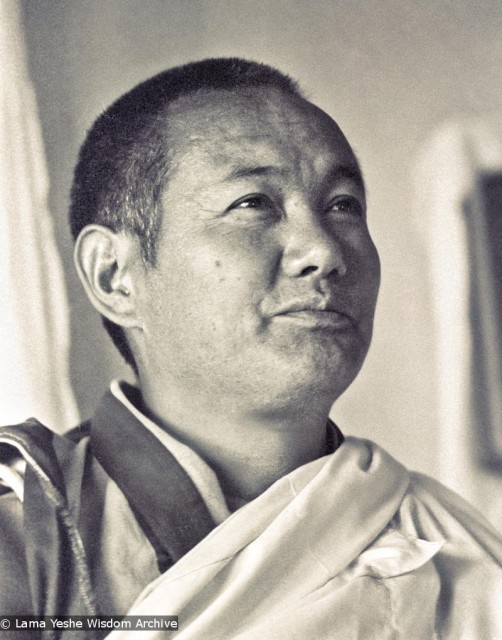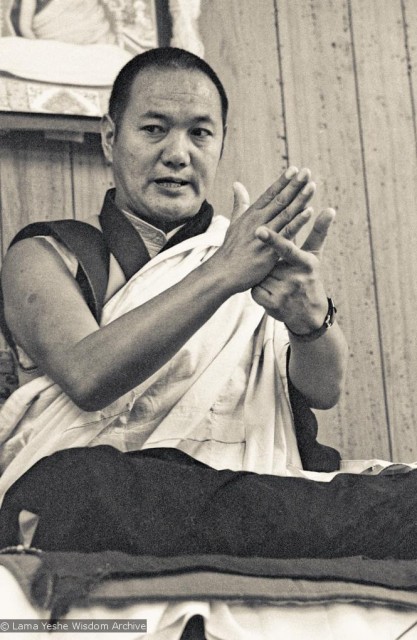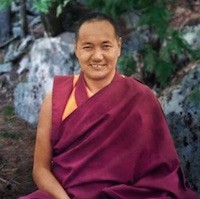
It’s very difficult to equalize things without changing people’s mental attitude. You can’t force everybody to be equal. It’s impossible. Without changing your mental attitude of attachment, it’s impossible to equalize everybody.
You can, however, completely change your internal world.
Without need of radical external change, you can achieve total inner equality and transform your too-extreme mind into a perfectly balanced one.
That’s the way to equalize others. It is very logical.
When you achieve mental equilibrium beyond the two extremes of attachment and hatred, your inner nature is even and peaceful instead of conflicted. The experience of inner equality also gives you a vision of beauty when you look at the outside world. You can see that beauty lies deeper than the surface, that human beauty lies within the person, beyond the form your sense perception apprehends. This extremely realistic view gives you a warm feeling for others.
How can you exist without relating to other human beings?
It’s impossible. You can’t live without relating to others. Throughout your entire life, your mind and brain relate to others.
Therefore, other people have a great influence over what comes into your mind. That’s why most human problems come from other human beings. We imitate each other. Human problems don’t come from someplace far away. To stop them, your attitude and behavior have to become humane.
When you realize how kind other sentient beings have been, instead of seeing them as repulsive or undesirable you’ll see them as beautiful. Instead of rejecting them you’ll have space in your mind to feel true love—profound, deep love for all sentient beings—and this feeling will be based on deep reasons, not superficial ones.
You’ll feel inner equilibrium instead of the usual extremes of attachment and hatred.

The logical reason for feeling that all sentient beings are equal is that equally, all sentient beings seek happiness, and not one, yourself included, wants to be unhappy. Think:
“All sentient beings want to be happy and no sentient being, myself included, wants to suffer. Whenever I experience an unpleasant feeling I want it to stop immediately. Although basically, all sentient beings equally desire happiness and freedom from suffering, out of the countless billions of beings, my fickle mind selects just one to make happy and forgets the others. When I encounter somebody who agitates me I see him as an enemy and want to give him harm, and when an enemy finds good fortune, I get jealous.”
Such a mind is unrealistic, unbalanced and extreme.
It’s as if two equally hungry and thirsty people come to your door. You look at them both but choose only one, “You can come in,” and tell the other, “You can’t come in. Go away.” You know that they’re in exactly the same predicament, that they’re both extremely hungry and thirsty, but your extreme, narrow mind picks one—“Come in, I love you. Put on some nice, clean clothes; have something to eat and drink”—and completely rejects the other.
This is the action of a narrow, silly, extreme mind. It all comes from the misconception of attachment, an unbalanced mind acting in an unrealistic manner that certainly has nothing to do with Buddhism or any other religion. Even if you check from the scientific, materialistic point of view, it’s unrealistic; even ordinary, nonreligious people would easily see that this kind of mind is ridiculous.
So what am I talking about here when I tell you to generate a feeling of equality with all living beings in your mind and concentrate on it?
Well, the way to do the Mahayana equilibrium meditation is to first do analytical meditation—intellectualizing a little on the equality of all sentient beings, as I mentioned above—and then, when you reach the point where at least intellectually you see their equality, let your mind remain in that feeling.
Enjoy it. It’s a remarkable experience.
And you should also maintain that feeling of equilibrium in your meditation session breaks—walking, eating, whatever you are doing.
It’s important to recognize that all desire, hatred and other delusions and the problems they bring come from attachment and ego. Actually, of the two, attachment and ego, it’s ego that comes first. Delusion starts with ego; attachment follows.
How is this? The concept of ego builds a projection of “I” and paints that polluted projection with a veneer of qualities. Then, when the “I”—superficial, artificial and illusory—starts looking at the pleasures of the sense world, it labels certain objects as desirable. From this, attachment arises, sticking, or clinging, to these attractive objects. This, very briefly, is the evolution of attachment.
The moment your ego says “I,” you automatically identify yourself as totally separate from other atoms, other people. On the basis of this view of two different things—self and other—you automatically see “I” as the most important one. Then, with attachment, your narrow mind chooses one particular atom as a source of sense pleasure. This then makes you view all other atoms as either irrelevant or as objects of hatred.
That’s the way it all starts.
In other words, when you perceive the hallucination of the self-existent, independent I, you immediately accept the existence of other. That other then appears as totally separate from you. If there were no I, there would be no appearance of other. But you build up that separateness, and this is where all the problems of samsara come from.
All this is the work of ego, which is a product of ignorance. Ignorance causes ego.
~
Read more from Lama Yeshe’s Ego, Attachment and Liberation. This book contains the teachings and meditations Lama gave at a five-day retreat that he led near Melbourne, Australia, in March 1975. Edited by Nicholas Ribush.
Freely available from Lama Yeshe Wisdom Archive.
~
Author Lama Yeshe
Editor: Toby Israel
Images: 1. Ursula Bernis; 2. Carol Royce-Wilder; 3. Carol Royce-Wilder


 Share on bsky
Share on bsky




Read 0 comments and reply